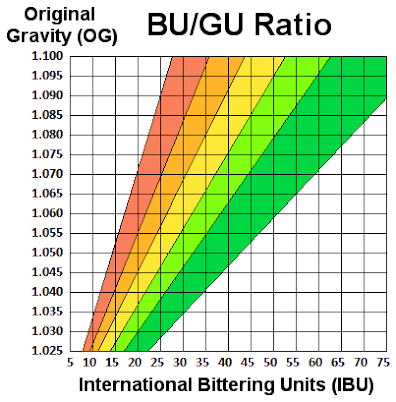This week I take a look at some of the factors affecting how bitterness in beer is perceived and how they interact in a finished beer.
Bitterness Perception in Beer
For many years, I thought that the International Bitterness Units (IBU) level drove the overall bitterness level in a finished beer. As I matured as a brewer, I gained an understanding of the balance between malt and bitterness reflected in the bitterness ratio and how maltiness offsets and balances bitterness.
As the IPA craze has come to dominate most craft breweries here in the US, substantial research has started into aroma oils, beer flavor perception, hop creep and more. Here’s a summary of some of the primary drivers of perceived bitterness as well as links back to more detailed articles on the individual measures.
- International Bitterness Units (IBUs): IBUs is a measure of the isomerized alpha acids in wort or beer. Technically IBUs are measured using light absorbance method, but functionally they represent a concentration of isomerized alpha acids in mg/L or parts per million (ppm). IBUs are mainly contributed by boiling hops, though hops continue some isomerization in the whirlpool post-boil as well. In an interesting twist of fate, IBUs are typically estimated and quoted for the wort pre-fermentation and not for the finished beer. Another consideration is that most people’s taste buds max out around 60-80 IBUs, and anything above that is just “really bitter.” So while brewing a 100+ IBU beer might be fun, you are really just adding vegetal matter above about 80 IBUs.
- Malt-Hop Balance and the Bitterness Ratio: Malt and alcohol add some sweetness to beer and counteract the bitterness from isomerized alpha acids from hops. Beers with high original gravities require higher levels of bitterness to achieve a balanced flavor profile. A simple measure of the balance is called the bitterness ratio which is found by dividing the estimated IBU by the gravity points (decimal part) of the original gravity. The chart above shows how this ratio varies from bitter (green) to malty (orange/red) depending on the gravity and IBU level in the beer.
- Yeast Attenuation: Attenuation refers to the percent of overall sugars fermented. Attenuation is often overlooked by brewers, but has a real impact on perceived bitterness. Some yeast strains have higher attenuation which means they will leave fewer residual sugars and dextrins in the finished beer. A low attenuation yeast will result in a higher finishing gravity with more residual sugars and less perceived bitterness. A high attenuation yeast will give a lower finishing gravity with less residual sugars, and a higher perceived bitterness. You can find the estimated attenuation for a given yeast strain on the supplier’s yeast data sheet.
- Water and the Sulfate/Chloride Ratio: Water also affected the perception of bitterness in the finished beer, though in a more subtle way than malt and hops. In particular, water that has substantially more sulfate than chloride ions (measured in parts per million or ppm) will create a beer that has a more bitter perception. Brewers have defined the Sulfate to Chloride ratio as a measure of this effect, and you can adjust your water to create a more malty or more bitter balance to suit the beer you are brewing.
- Hop Aroma Oils – Whirlpool and Dry Hopping: In addition to hops, malt and water used in the boil, many craft beers also add hops in the whirlpool (post boil rest) and dry hop after fermentation. While whirlpooling adds some bitterness, the primary driver behind these two techniques is to infuse aroma oils from the hops into the finished beer. While the aroma oils don’t directly add IBUs (alpha acids) they are picked up by the nose when the beer is consumed and enhance the perception of bitterness and freshness in the finished beer. Adding aroma oils via whirlpool or dry hopping enhances the perception of bitterness.
I hope you enjoyed this week’s article on perceived bitterness and beer. Thanks for joining me on the BeerSmith Home Brewing Blog. Be sure to sign up for my newsletter or my podcast (also on itunes…and youtube) for more great tips on homebrewing.
